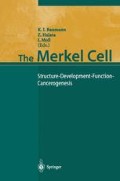Summary
Merkel cell carcinomas are believed to be derived from the Merkel cells of the epidermis and hair follicles. The histogenesis of the Merkel cells has not yet been fully elucidated, but several studies suggest that they might originate from an asymmetric cell division of basal keratinocytes or epithelial stem cells of the fetal epidermis, and the resulting differentiated Merkel cells have presumably lost their growth potential.
The capability of indefinite cell division in germ line cells and in the great majority of malignant tumors as well as an increased growth potential in certain somatic cells (such as basal cells of renewable tissues) is correlated with cellular telomerase activity, which is absent in differentiated somatic cells. In this study, the telomerase activity in cryostat sections of frozen Merkel cell tumor biopsies and in in vitro cultivated Merkel cell carcinoma cells was analyzed. The presence of the typical Merkel cell carcinoma phenotype was confirmed in all tumor specimens and cell lines by immunohistochemical staining for the cytokeratin CK 20, which was present in the typical plaque-like distribution. Microdissection was employed on the cryostat sections to concentrate tumor material and to remove potentially telomerase-positive contaminating elements such as epidermis and hair follicles. Telomerase activity was measured by the polymerase chain reaction-based telomeric repeat amplification protocol (TRAP) assay.
We detected telomerase activity in all four tumors studied and three of four cell lines. Control experiments showed a lack of telomerase activity in normal liver and kidney tissue and telomerase positivity in a breast carcinoma biopsy and activated lymph node, as expected. Immunohistochemistry demonstrated the presence of the catalytic subunit of telomerase in nearly all nuclei of Merkel cell carcinomas.
These results show that despite their pronounced neuroendocrine differentiation and their occurrence in patients of advanced age, Merkel cell carcinomas possess telomerase activity similar to that of common carcinoma types. In future studies, the (difficult) procurement and subsequent analysis of early stages of Merkel cell carcinomas might help to interpret the present findings and to reveal more about the biology of this peculiar type of malignant tumor.

Telomerase activity of Merkel cell carcinoma tissues. Depicted are the TRAP assay products following gel electrophoresis for a positive control cell line (P), four Merkel cell carcinoma tumor specimens (1–4) and normal liver tissue as a negative control (N). The presence of the characteristic “ladder” of DNA fragments indicative of a positive TRAP assay is seen in the positive control lane and in all four tumor samples
Access this chapter
Tax calculation will be finalised at checkout
Purchases are for personal use only
Preview
Unable to display preview. Download preview PDF.
References
Greider CW (1998) Telomerase activity, cell proliferation, and cancer. Proc Natl Acad Sci USA 95: 90–92
Harley CB, Futcher AB, Greider CW (1990) Telomeres shorten during ageing of human fibroblasts. Nature 345: 458–460
Hiyama E, Hiyama K, Yokoyama T et al. (2001) Immunohistochemical detection of telomerase (hTERT) protein in human cancer tissues and a subset of cells in normal tissue. Neoplasia 3: 17–26
Liu K, Schoonmaker MM, Levine BL, June CH, Hodes RJ, Weng NP (1999) Constitutive and regulated expression of telomerase reverse transcriptase (hTERT) in human lymphocytes. Proc Natl Acad Sci USA 96: 5147–5152
Stöppler H, Conrad Stöppler M, Holzbach A, Houdek P, Moll I, Moll R (2001) Telomerase activity of Merkel cell carcinomas and Merkel cell carcinoma-derived cell lines. Arch Dermatol Res 293: 397–406
Author information
Authors and Affiliations
Editor information
Editors and Affiliations
Rights and permissions
Copyright information
© 2003 Springer-Verlag Berlin Heidelberg
About this paper
Cite this paper
Stöppler, H. et al. (2003). Merkel Cell Carcinomas Possess Telomerase Activity. In: Baumann, K.I., Halata, Z., Moll, I. (eds) The Merkel Cell. Springer, Berlin, Heidelberg. https://doi.org/10.1007/978-3-662-10358-6_35
Download citation
DOI: https://doi.org/10.1007/978-3-662-10358-6_35
Publisher Name: Springer, Berlin, Heidelberg
Print ISBN: 978-3-642-05574-4
Online ISBN: 978-3-662-10358-6
eBook Packages: Springer Book Archive

